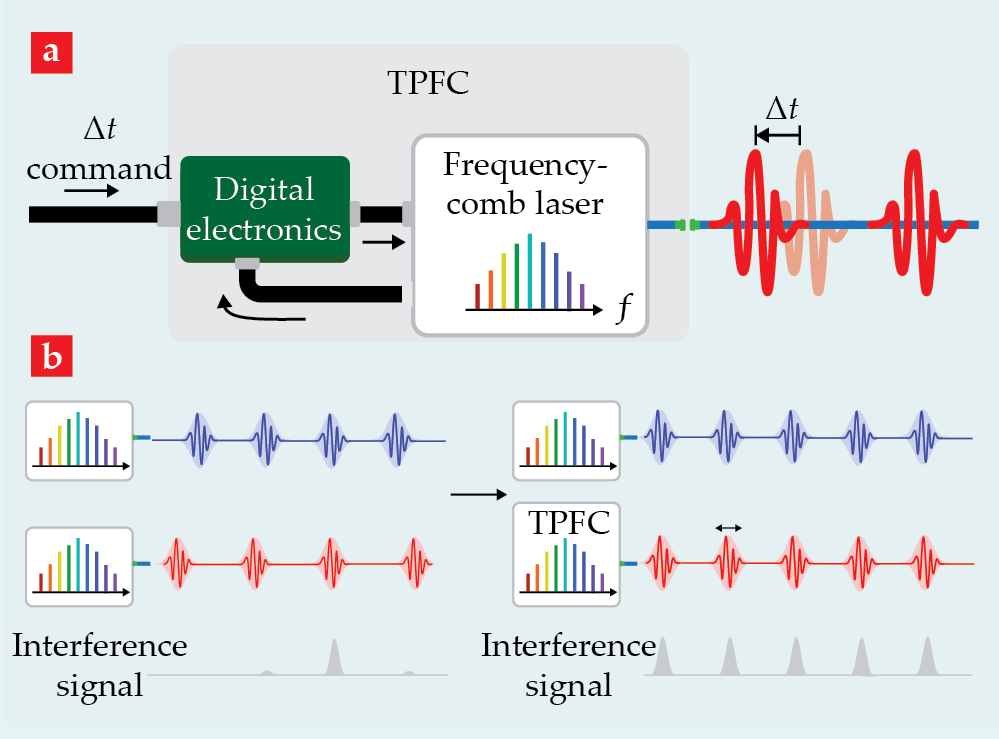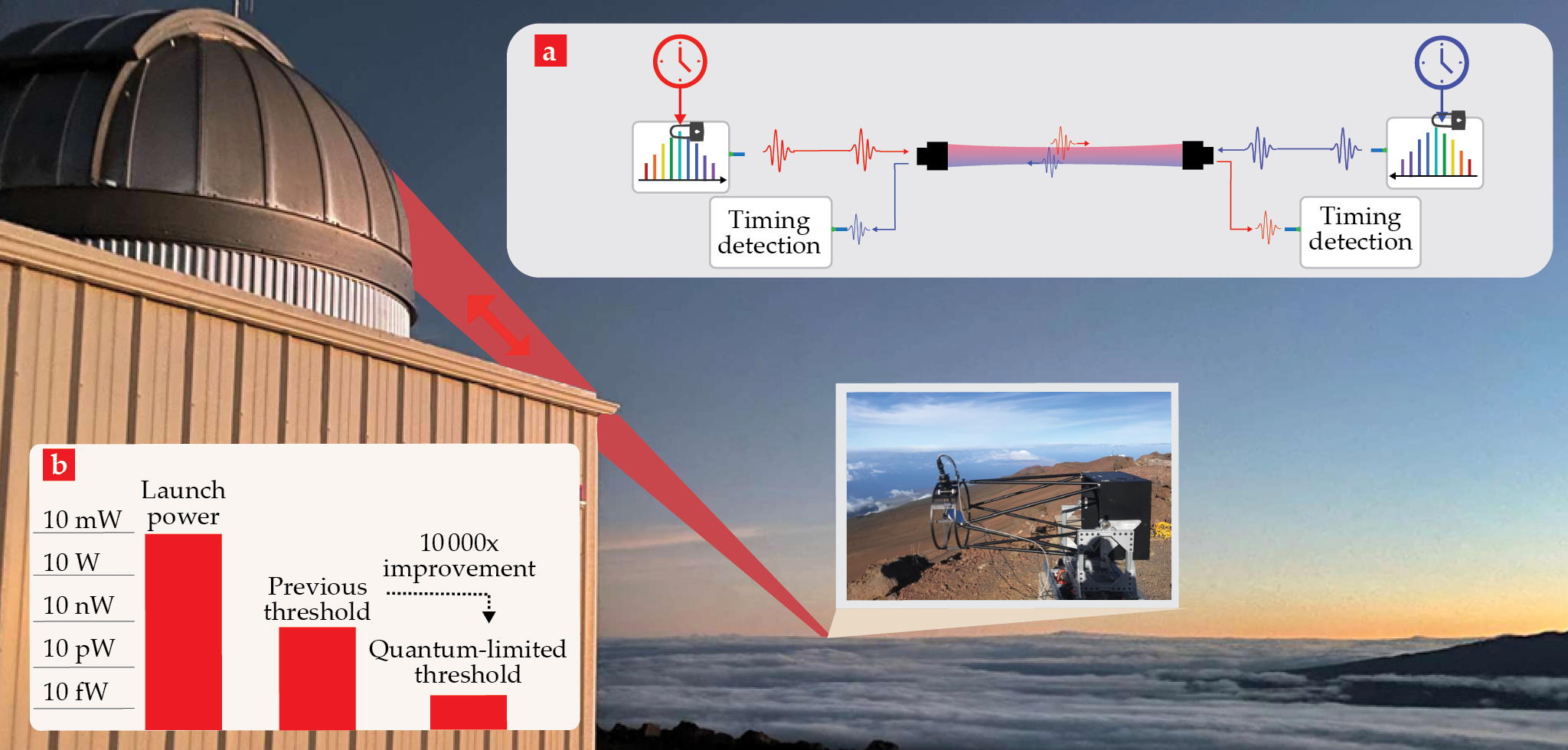Comparing clocks by using pulses of light
DOI: 10.1063/pt.czpd.mjuy
Look carefully, and you will see clocks all around you: The plant wilting on your desk tells you that a week has passed since you watered it; the setting Sun tells you that another day has gone by; your smartphone tells time with its GPS-calibrated clock set by pinging satellites in space. Although we tend to experience time on the scale of seconds to years, scientists have developed ways to measure time at the level of 1 part in 1018 by using optical atomic clocks, which determine time by probing atomic resonances with lasers. That’s equivalent to measuring the distance from Earth to the Moon with an uncertainty of less than half a nanometer. Such extremely precise clocks offer new ways for physicists to, for example, test general relativity, search for dark matter, and probe variations in fundamental constants.
To do many of those experiments, researchers look for unexplained variations between two physically separated clocks—an ideal future testbed would be one in space and one on Earth. The ability to compare time across such distances is the domain of what’s known as time transfer. Time transfer is the basis for GPS, which operates at the submicrosecond level and uses RFs. Although it can synchronize communications networks and power grids, GPS is not precise enough for fundamental physics tests. Instead, optical clocks supported by optical time-transfer methods are needed for those experiments.
Free-space optical time transfer is a technique that uses frequency combs—trains of equally spaced ultrashort pulses—to compare time between optical clocks at the femtosecond level across hundreds of kilometers of air. Until recently, the technique was limited to tens of kilometers, due to diffractive and turbulence-induced losses. But with the invention of the time-programmable frequency comb (TPFC), that range was pushed to 300 km with margin to spare. Because a laser beam traveling through 300 km of turbulent air experiences the same loss expected for one traveling from the ground to a geosynchronous satellite, the door is now open to future ground-to-space time transfer.
Time-programmable frequency comb
Lasers abound in the metrology world, but perhaps the most useful is the optical frequency comb (see Physics Today, June 2000, page 19
Physicists usually think of comb stabilization in the frequency domain, but it also fixes the two degrees of freedom in the time domain: pulse-to-pulse spacing and the pulse phase—the relative phase between the carrier wave and the pulse envelope. In a conventional frequency comb, these two degrees of freedom are stable but rigid. The TPFC combines an optical fiber frequency comb with digital electronics running new firmware that maintains the underlying stability but lets the user select the pulse timing and phase, as shown in figure
Figure 1.

A time-programmable frequency comb (TPFC), which is based around a conventional frequency-comb laser, (a) converts a user-input timing command, Δt, to a timing shift in output pulses. (b) Two schemes measure the timing. In both, the timing of the comb under test (blue) is measured by mixing it with a second frequency comb (red) to generate interference signals on a photodiode (gray). In a conventional dual-comb timing measurement (left), the combs run at different rates, and timing shifts of the interference peaks directly map onto timing shifts in the comb under test. In tracking-style detection (right), interference in the signal amplitude is used as feedback to force the TPFC measurement to track the comb under test. Tracking-style detection requires 1/10 000 as much light as the conventional measurement technique.

Although the ability to move light around is striking, the real power of the TPFC comes from how it changes one’s ability to measure other comb pulses. Generally, the best way to measure the timing of a comb pulse is with another frequency comb. In a conventional dual-comb timing measurement, one offsets the spacing of pulses between the comb being tested and a measurement comb. When the mixed light from the two lasers hits a photodiode, it generates a peak in the interference signal when the pulses overlap in time, as shown in figure
The problem with that technique is the long dead time between the interference signal peaks. With the TPFC, however, there no longer is any dead time. Instead, it tracks the pulses of the comb under test in time with the control signal because the tracking also acts as the timing measurement.
With no dead-time penalty, the tracking-style detection operates at the quantum limit—also called the photon-shot-noise limit. The noise in the measurement is then dominated by the quantized nature of light, and the signal-to-noise ratio of the measurement is set by the number of received photons. The quantum limit represents the best measurement possible in a classical system for a given optical power.
Quantum-limited time transfer
The advantage of quantum-limited detection becomes clear when you consider it in an application such as free-space optical time transfer. In the system shown in figure
Figure 2.

The Mauna Loa Observatory (foreground) on the island of Hawaii sends a laser pulse as part of an optical time-transfer demonstration over the 300 km round-trip distance between it and a cat’s-eye retroreflector (inset) on Maui. (a) A frequency comb referenced to a stable laser sends its pulses to the other clock’s site over a bidirectional free-space link. Combining the pulses at each site yields the timing offset between the two clocks. (b) Time-programmable frequency combs enable quantum-limited timing detection, which reduces the power required for time transfer by 10 000. (Adapted from E. D. Caldwell et al., Nature 618, 721, 2023.)

To compare two clocks, then, one needs to compare the timing of the pulses in the two frequency combs. That’s done by sending comb light bidirectionally through the atmosphere and detecting when the incoming pulses reach both sides. The bidirectional link is critical because combining the measured time signals on both sides cancels the time-of-flight noise that comes from atmospheric optical turbulence or slow platform motion.
Substituting TPFCs for conventional combs and using the tracking-style detection scheme yields striking results for time transfer. Making those changes reduces the required received power by 10 000 and increases the working distance from tens to hundreds of kilometers for the same amount of launched laser light.
Figure
References
► T. Fortier, E. Baumann, “20 years of developments in optical frequency comb technology and applications,” Commun. Phys. 2, 153 (2019). https://doi.org/10.1038/s42005-019-0249-y
► A. Derevianko et al., “Fundamental physics with a state-of-the-art optical clock in space,” Quantum Sci. Technol. 7, 044002 (2022). https://doi.org/10.1088/2058-9565/ac7df9
► E. D. Caldwell et al., “The time-programmable frequency comb and its use in quantum-limited ranging,” Nature 610, 667 (2022). https://doi.org/10.1038/s41586-022-05225-8
► E. D. Caldwell et al., “Quantum-limited optical time transfer for future geosynchronous links,” Nature 618, 721 (2023). https://doi.org/10.1038/s41586-023-06032-5
More about the Authors
Emily Caldwell and Laura Sinclair are researchers at NIST in Boulder, Colorado.


